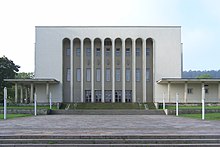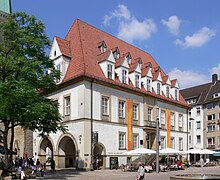Rudolf-Oetker-Halle
As a stage and orchestra of the city of Bielefeld , the record on Theater Bielefeld and Bielefeld Philharmonic total of eight venues in three houses: City Theater, Theater at the Old Market (TAM) and Rudolf-Oetker-Halle. With a total of almost 3,200 places, they form the second largest cultural institutions in North Rhine-Westphalia. The three branches - musical theater , dance and acting- as well as the orchestra and the concert hall are under the direction of Michael Heicks (Intendant) and Ilona Hannemann (Administrative Director). The management team includes those responsible for the divisions Nadja Loschky (artistic director of music theater), Simone Sandroni (artistic director and chief choreographer of TANZ Bielefeld), Christian Schlüter (drama director) and Alexander Kalajdzic (general music director).
General
The concert hall
The Rudolf-Oetker-Halle is a concert hall in Bielefeld . It was built in 1929-1930 according to plans by the Düsseldorf architects Hans Tietmann and Karl Haake and inaugurated on October 31, 1930. In the early 1950s, the Rudolf-Oetker-Halle was considered one of the best sound halls in the world. The Rudolf-Oetker-Halle has been one of the stages and orchestras in the city of Bielefeld since 2018. The name of the concert hall goes back to a foundation of the Oetker family, founded in memory of Rudolf Oetker , who died in the First World War in 1916 , who had already campaigned for the construction of a concert hall in Bielefeld during his lifetime and who played the piano and organ himself.
location
The concert hall was built in the west of Bielefeld on a slope on the northern edge of the Teutoburg Forest. The west side of the Bürgerpark was chosen as the location . The SchücoArena is also in the immediate vicinity . The stop Rudolf-Oetker-Halle of the Stadtbahn Bielefeld is under the forecourt of the hall. The concert hall and the city theater, in the center of Bielefeld, are four stops away from each other on the 4 tram.
The construction and the architecture
In 1929 the magazine “Neue Werkkunst” praised the architectural work of Hans Tietmann and Karl Haake for “a sense of monumental power and at the same time - grace - sensitivity for honest objectivity and love of truth - preference for the simple, demanding, self-evident (...) - skillful Adaptation to the environment (...) ". The simple, rectangular floor plan of the hall, also characterized as “shoe box architecture”, is based on the large music club hall of the Gesellschaft der Musikfreunde in Vienna.
The elongated, brightly plastered concert building has lower extensions on both sides and a staircase extension on each side. The external appearance is characterized by the nine distinctive arched openings in the north facade. A wide staircase extends in front of the entrance. Above the entrance hall and the foyer there is the large hall with a maximum of 1542 seats on the upper floor, and the small hall with approx. 300 seats adjoins the facade. The foyer has been used as a new venue since 2018 and has around 120 seats. The architecture of the concert building was adapted to optimize the acoustics.
In the Great Hall, after the large Walcker organ from the Hans Sachs House in Gelsenkirchen has been removed and stored, the last large “invisible” concert hall organ in North Rhine-Westphalia is in an organ chamber behind the orchestra podium ( W. Sauer Orgelbau , III / 53, converted by Willi Peter, Cologne).
Acoustics
Through the acoustician Professor Dr. Eugen Michel used the materials and the deliberately used absorption surfaces, the Great Hall immediately becomes a sound body. The entire ceiling serves as a resonance surface, consisting of large, painted plywood panels that hang at a distance under a sound-absorbing pumice concrete ceiling. The large ceiling lights in their special shape are also necessary to diffuse sound, as are the gradations of the ceiling mirror, the protruding wooden frames of the windows and the door niches in the parquet area. After a scientific study and questioning of 20 important conductors by Dr. Ing.Fritz Winckel, the Rudolf-Oetker-Halle was one of the ten best sound halls in the world in 1955. The excellent reverberation effect of the Rudolf-Oetker-Halle also enables high-quality recordings, for example the Westdeutscher Rundfunk transmits a live sound recording, for example at the festival at the beginning of the season of the stages and orchestras of the city of Bielefeld on September 8, 2018
history
In 1925 the Oetker family decided to commemorate Dr. Rudolf Oetker to finance a concert hall for her hometown. This was mainly supported by Lina Oetker, the wife of the company founder August Oetker and mother of the late Rudolf, as well as by Wilhelm Lamping, the musical master builder. The latter did not live to see the inauguration of the concert hall because he died on September 7, 1929. First, the concert hall was to be built on the urban area of the museum garden, where the art gallery is now. In the spring of the following year, however, the decision was made, on the initiative of Mayor Rudolf Stapenhorst , for the location on the west side of the Bürgerpark. The Düsseldorf architects Hans Tietmann and Karl Haake won the 1927 architectural competition for the construction of the concert hall. In 1928, the design was optimized in order to guarantee the first-class acoustics of the concert hall. After the completion of the concert hall, the Rudolf-Oetker-Halle was inaugurated on October 31, 1930 under the direction of Max Cahnbley with the city orchestra. The gala concert with pieces by Brahms, Bach and Beethoven was broadcast by the Cologne radio station. To complete the entire complex, the city tried to build a restaurant, but the project had to be postponed due to the poor general economic situation in the thirties. In 1931 the Musikverein donated a bronze bust in honor of Lamping, which is still in the gallery on the first floor of the concert hall.
In 1934 the city of Bielefeld declared Lina Oetker an honorary citizen. and that year donated a bust of the city's music director Heinrich Kaminski, who was director of the Bielefeld city music club from 1931 to 1934 and who was responsible for the city's symphony concerts in the Rudolf-Oetker-Halle. The north-western porch of the Rudolf-Oetker-Halle in the direction of Lampingstrasse was destroyed by a bomb attack during the Second World War in 1944. However, the damage was repaired with the support of the Oetker family . The Oetker family also financed other construction costs . On September 30, 1945, the anniversary of the heavy bombing raids, the Rudolf-Oetker-Halle celebrated its reopening with Mozart's Requiem. As a thank you, the city of Bielefeld had a bust of Rudolf Oetker erected in the concert hall in the entrance hall in 1965.
Over the years, popular music artists such as Udo Jürgens and Reinhard Mey have also found their way into the Rudolf-Oetker-Halle. During the renovation of the city theater in 2004-2006, the music theater of the city theaters played in the Rudolf-Oetker-Halle, which was temporarily converted by architect Frank Otterbach. The concert hall was then returned to its original state after two seasons. Since 2018 the Rudolf-Oetker-Halle has been the third venue for the stages and orchestras of the city of Bielefeld. On September 7, 2018, the newly designed and converted foyer of the Rudolf-Oetker-Halle was inaugurated with a festive gala: the room, which was previously characterized by cloakroom racks, was given structure with curtains and the acoustics improved, a large bar of almost 30 meters around it adorns Foyer and lounge furniture create a cozy atmosphere. In addition, a stage was set up that is used for readings, theater, concerts and dance events. The architectural office Wannenmacher & Möller GmbH received the symmetrical axis of the concert hall, as well as the historical and listed building fabric. In addition to the ensembles of the Bielefeld city's stages and orchestras, prominent musicians such as Isabelle van Keulen , Håkan Hardenberger and Tom Gaebel also provided entertainment for the guests at the gala. As part of the FEST! The Rudolf-Oetker-Halle is transformed into a broadcasting hall through cooperation with WDR3. At the Last Night of the Proms in September 2018, the Bielefeld Philharmonic played a two-hour concert, after which the event was broadcast live from London. The opening of an outdoor restaurant for the Rudolf-Oetker-Halle is planned for the summer of 2019.
Web links
- Website of the Rudolf-Oetker-Halle
- Website of the Bielefeld Philharmonic Orchestra
- Website of the Bielefeld Theater
- Bielefeld Theater Foundation
Individual evidence
- ↑ https://theater-bielefeld.de/unser-theater/buehnen-und-orchester-der-stadt-bielefeld.html stages and orchestras of the city of Bielefeld Theater Bielefeld Retrieved on October 30, 2018
- ↑ https://rudolf-oetker-halle.de/rudolf-oetker-halle/ueber-uns.html Rudolf-Oetker-Halle; Profile Retrieved December 17, 2018
- ^ Friedrich Ernst Huebsch Verlag (1929): Neue Werkkunst: Architectural Monographs in the Twenties Berlin
- ↑ https://www.baukunst-nrw.de/objekte/Rudolf-Oetker-Halle-Bielefeld--2211.htm Baukunst NRW: Rudolf-Oetker-Halle Bielefeld; Civil Engineering Accessed January 4, 2019
- ↑ http://www.orgel-owl.de/bielefeld.htm Orgeln der Stadt Bielefeld Retrieved on January 4, 2019
- ↑ a b c City of Bielefeld, Hoffmann, D. (1980): 50 years of Rudolf Oetker Halle Bielefeld Kramer-Druck, Bielefeld
- ↑ https://www.nw.de/lokal/bielefeld/mitte/20686810_Die-Geschichte-der-Oetkerhalle.html Güntter, T. (2016) The history of the Oetker Halle Retrieved on January 4, 2019
- ↑ https://www.nw.de/lokal/bielefeld/mitte/20686810_Die-Geschichte-der-Oetkerhalle.html Güntter, T. (2016) The history of the Oetker Halle Retrieved on January 4, 2019
- ↑ http://www.musikverein-bielefeld.de/index.php/Geschichte.html The history of the music association of the city of Bielefeld. Accessed on January 7, 2019
- ↑ https://www.bielefeld.de/de/rv/ds_stadtverwaltung/isb/hib/roeh/ Witthaus, Hannemann (2017): Action Concept ROH Retrieved on January 7, 2019
- ↑ https://rudolf-oetker-halle.de/rudolf-oetker-halle/ueber-uns.html Rudolf-Oetker-Halle; Profile Retrieved December 17, 2018


